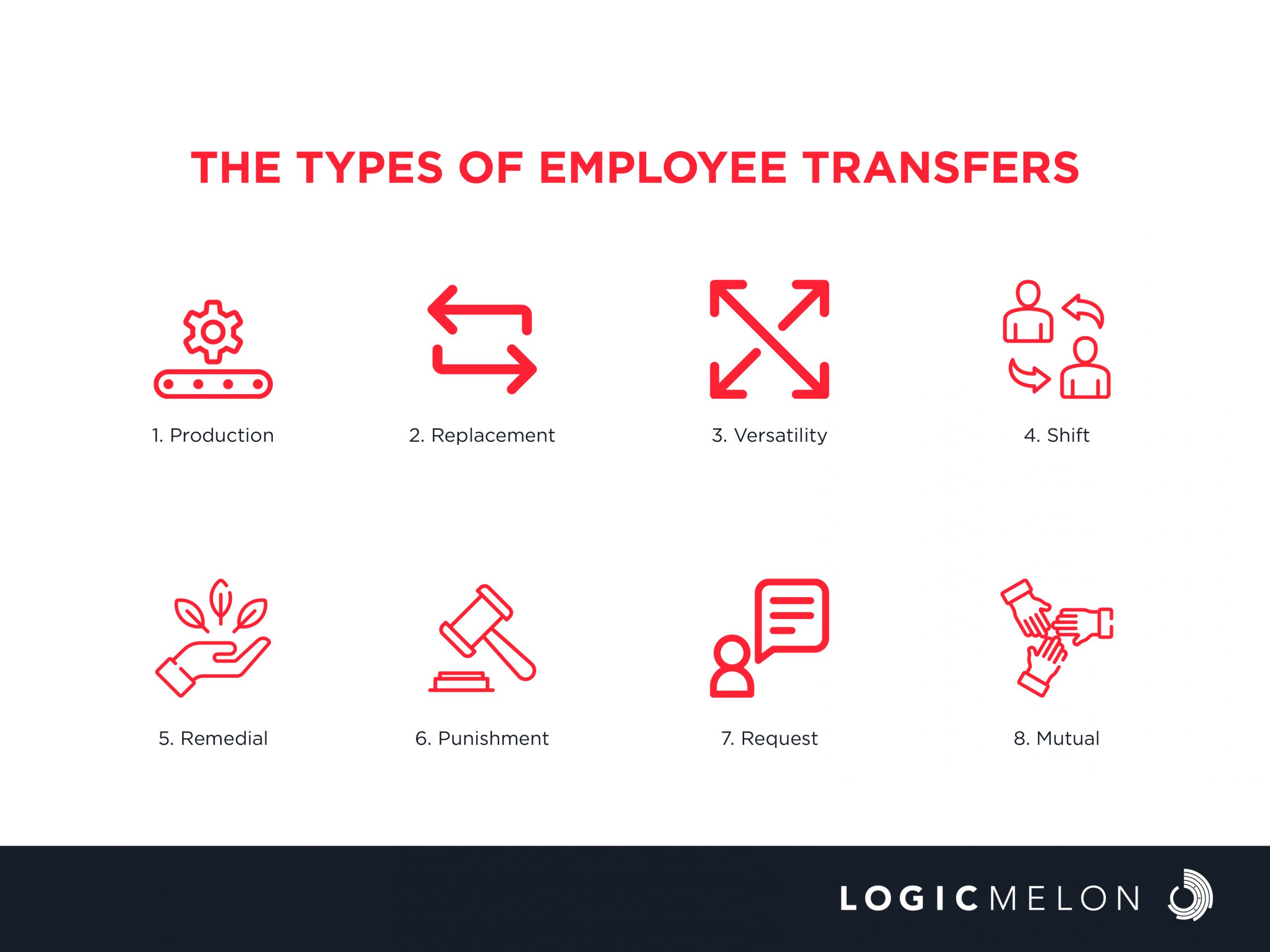The Types of Employee Transfers
An employee can be shifted from one job to another, usually, at a different location, department or unit which is a type of employee transfer. Employee transfers can be temporary or permanent depending on the decision of both parties, employer and employee.
The Importance of an Employee Transfer
The importance of an employee transfer is to increase the effectiveness of the organisation. Employee transfers help to solve problems that a department faces by employing people from other departments. Developing an employee transfer strategy decreases the stress associated with work transfers.
An internal job transfer seeks growth, and can often offer new challenges, responsibilities, and opportunities for growth. If you have exhausted the opportunities for development in your current position, transferring to different departments or locations can allow you to develop skills and connections.
The Types of Employee Transfers

1. Production
These transfers are made to meet the company’s requirements. The surplus employee can be transferred to the department or the required location. The movement of employees within the organisation, due to changes in production requirements can help to stabilise the organisation.
2. Replacement
This is to replace the old employee with a new employee. These transfers help to stabilise the department by giving relief to a senior employee who might be feeling the heavy pressure of work. This type of transfer can also move short-service employees even though the objective of the transfer is to retain well-trained and efficient employees in the process.
3. Versatility
This type of transfer is made to develop all the employees by moving them from one job to another and helping them to explore new challenges around the organisation. Generally, the salary of an employee remains the same but can change depending on the nature of the work. The base salary of the transferred employee will be reviewed during the review process.
4. Shift
This is a common practice where there is one shift and these transfers are suitable where there is regularised rotation. Shift transfers help employees to avoid exhaustion, and are the act of an employee who is moved with the instruction of the department, from one shift to another.
5. Remedial
These transfers are made to rectify mistakes from the Selection and Placement Department. The wrongly placed employees can be corrected. Initial placement of the employee for the role does not have the suited skills they possess, so they change for the position where they are better suited.
6. Punishment
Punishment transfers are usually done by the company to punish their employees for some type of reason that might abide by their company’s rules and regulations. A punishment transfer is a form of transfer of service to an employee to an inconvenient place. It is used to correct any poor performance or rough behaviour of an employee.
7. Request
The employee in an organisation does a request transfer. It is done on humanitarian grounds to help the employee look after their personal problems. In this case, the employee is publicly stating their desire to move and encouraging other departments to make an offer of employment. When the transfer request comes from the employer himself, it is because the employer does not like the work or place of work or the co-workers.
In case of request transfers, explain to your employer in a way they understand the primary motivation is to move toward a new job for the opportunity, and not away from them due to any concerns.
8. Mutual
When there is a mutual agreement between the employer and employee to transfer from one place to another. Generally, when an organisation accepts the employee’s request for transfer it becomes a transfer by mutual consent.
Reasons for Employee Transfer
When there is a shortage of employees in one department of the organisation due to high demand, and there is a surplus of employees in another department, the workers are sometimes shifted from one department to another. Some positions might require distinctive skills, competency, and expertise from transferred employees. To make the employees more competent and versatile, these transfers are made.
Usually, these transfers take place approximately with the same salaries. A slight change in responsibilities and duties can also increase the payment.
Frequently Asked Questions
1. Can you transfer employees to another company?
The company does not hold the power to transfer employees to another company, but the employees, by their own will, can change their company. Your employer can transfer your employment to another company, and the new employer will take over your contract of service.
2. What is the process of transferring an employee from one department to another called?
Transferring employees from one department to another is known as a horizontal transfer, which happens within an organisation. This is a process wherein there is a change in the job, with changes in their terms and conditions.
3. What are the types of employee transfers?
The types of transfers are on the basis of production, replacement, versatility, shift, remedial, punishment, request, and mutual.
4. What is the importance of employee transfers?
The importance of an employee transfer is that employees are allowed to move to the place they feel most interested. These transfers have an impact on employees’ morale and they are allowed to switch according to their interests. Employee transfers are part of the company’s policies and have to follow this set of policies for the smooth transfer of employees.
Closing Thoughts
Transfer employees can be internal or external mobility in which the employee is shifted from one job to another usually at a different location, department, or unit. Transfers can be classified as temporary or permanent transfers. These transfers can either be temporary or permanent, depending upon the decision made by the employer and employee.
In an organisation, employee transfers are made to stabilise employment and avoid layoffs.
There are also some drawbacks that come with transferring employees, and as a possibility of failure, employees having an attachment to the organisation can also leave the organisation. Employee transfer can lead to resignation if they have to leave their current location, and the location they are working in is comfortable for them.
LogicMelon
Award-winning recruitment software that will find, attract, hire and analyse the way you want to work. At LogicMelon, we have experienced software recruitment marketing specialists to help you build effective recruitment solutions supported by the best customer service you’ll find anywhere!
Email: sales@logicmelon.com or call LogicMelon (UK) +44 (0) 203 553 3667 (USA) +1 860 269 3089
Recruitment Crisis Management
Recruitment crisis management requires adaptability, strategic thinking, and a proactive approach to address talent shortages and avoid disruptions.
Candidate Matching: Everything You Must Know
To successfully implement an ATS, it is important to consider certain factors. Learn more by reading this blog.
Streamlining Recruitment: ATS Implementation Best Practices
To successfully implement an ATS, it is important to consider certain factors. Learn more by reading this blog.


